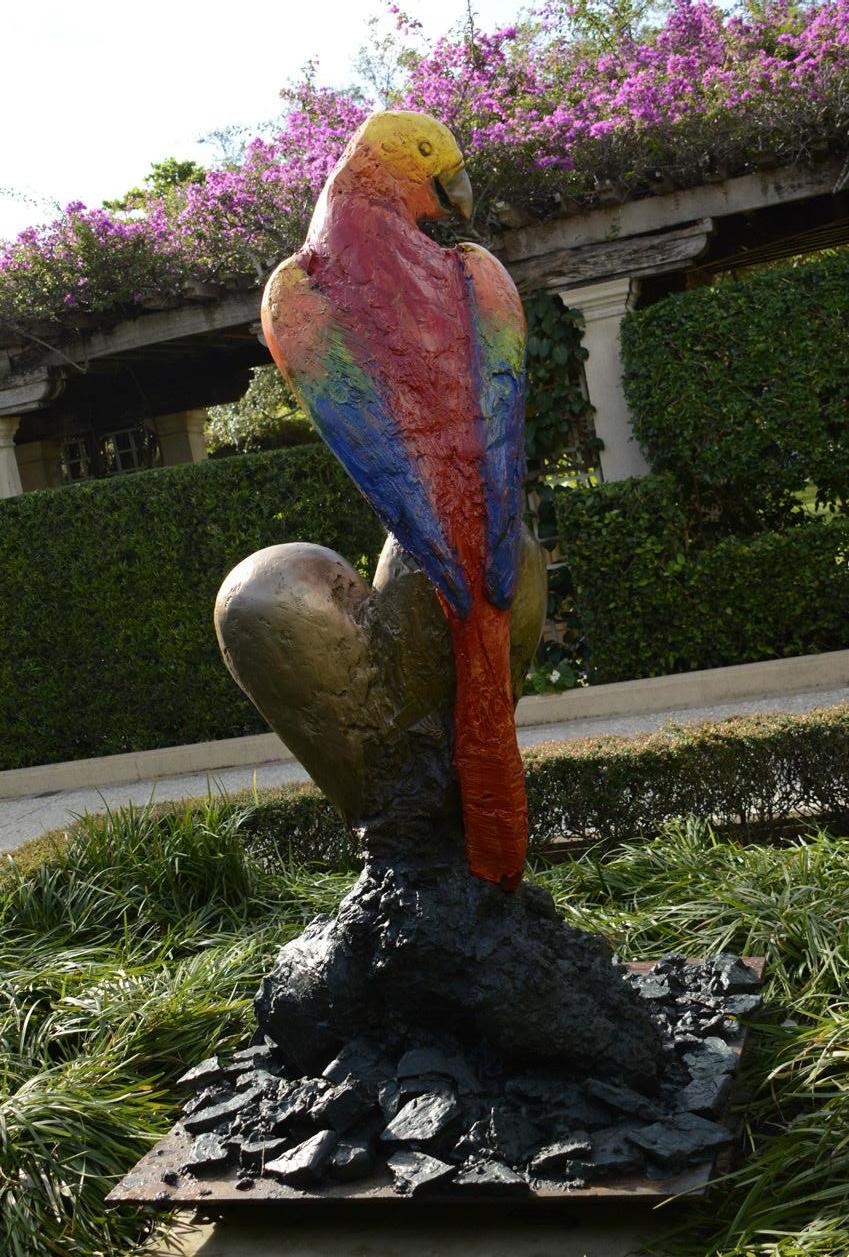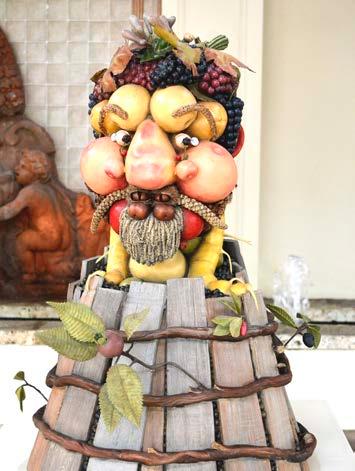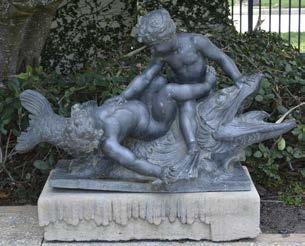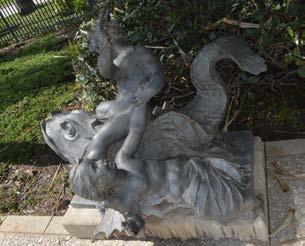
4 minute read
Gardens
No charge ■ Open daily from 10 a.m. to 5 p.m., weather permitting No reservations needed ■ For more information, click on www.fourarts.org
Stunning Restorations
Visitors to the Philip Hulitar Sculpture Garden and Four Arts Mall will notice restorations to two of our signature sculptures, King Parrot by Jim Dine and Intetra by Isamu Noguchi.
Alan Solomon wrote of Jim Dine, whom he had included among ‘Four Younger Artists’ in his sensational U.S. Pavilion at the Venice Biennale in 1964, that “Although he is often counted among the Pop Artists, Dine’s work really relates to that of no other artist. Starting from a point of view close to Rauschenberg and Johns, he had evolved toward a highly personal mode of expression.” Dine, painter, sculptor and print maker, was born in Cincinatti, Ohio on June 16, 1935. The motif of the heart in Dine’s work goes back at least to 1966, and to his earliest major sculpture, Nancy and I at Ithaca (Straw Heart), when Dine was teaching at Cornell University. Nancy Minto (d. 2020) was his wife and it has been said that his hearts are “touching and powerful, full of joy and affection.” This is poignant, given that Mary Tremaine Hildt’s gift commemorates her late son.
The parrot is actually a scarlet macaw from the Amazon, where it has been associated by Indians with the transmigration of souls (a ‘psychopomp’ is a carrier of souls). In 1966 the Arte Povera artist Jannis Kounellis placed a live macaw before a sheet of metal to construct the metaphor of art reflecting and mimicking (‘parroting’) reality. The macaw gives us a sense of aspiration and of the joy of color expressed in paint. The work’s paint had faded in recent years, so The Four Arts arranged for Dine to oversee the restoration work and approved the final product, which returns King Parrot to its original, dramatic bright colors.
Photos by ELVIO SALAZAR

Jim Dine, American (b. 1935) King Parrot, 1995 Painted and polished bronze Gift of Dorothy Tremaine Hildt in memory of her son K. Bryant Wick, Jr. Collection of The Society of the Four Arts, 2014.1
Intetra has graced the Intracoastal Waterway at The Four Arts since 1976. Over years of exposure to the weather, the clear linear patterns, lines, and details buffed into the sculpture had faded away. They have now been restored, with the conservator adding a layer of sealant to protect it against the elements.
Isamu Noguchi, Japanese, (1904-1988) Intetra, 1976 Steel Gift of The Ziuta and Joseph James Akston Foundation Collection of The Society of the Four Arts, 1976.2
Don’t miss The Four Seasons
An amazing addition to the Philip Hulitar Sculpture Garden when installed during the summer, contemporary American artist Philip Haas’ The Four Seasons (2010) exhibition will end its run at The Four Arts on December 31.
The group of painted fiberglass sculptures are inspired by the portrait series by Italian Mannerist Giuseppe Arcimboldo (1526/1527–1593). As in Arcimboldo’s whimsical paintings, the physical features of the four figures are rendered in floral, fruit and vegetables appropriate to each season.
Arcimboldo, the court portraitist to the Habsburg Imperial Courts in Vienna and Prague for 25 years, painted The Four Seasons in 1563 and presented them to Maximilian II on New Year’s Day, 1569. Hailed for their wit and artifice, the paintings were popular at court and solidified his reputation as the most modern painter of his time.
Photos by ELVIO SALAZAR

Philip Haas, Autumn, 2010, painted fiberglass, on loan from the artist
Haas’s interpretations made in 2010 of Arcimboldo’s eccentric yet scientifically accurate composite heads are puzzles crafted with flowers, ivy, moss, fungi, vegetables, fruit, trees, bark, branches, and twigs. The ‘theater’ of the Pannill Pavilion provides the
Philip Haas The Four Seasons
ON DISPLAY
Through Thursday, December 31 Pannill Pavilion inside the Philip Hulitar Sculpture Garden
perfect ‘stage set’ for the sculptures. Their reconfigurations of the human head delight visitors of all ages. Haas’s sculptures also offer a revelatory viewing experience: he recreates two-dimensional paintings as three-dimensional forms, allowing viewers to walk around them and witness nature’s rhythmic cycles from different vantage points.
The Four Seasons is on loan to The Society of the Four Arts from the artist. The exhibition of The Four Seasons is made possible by the generosity of Alice (Kit) Pannill.
Artist Unknown, Franco-Flemish, active mid to late 19th-century Pair of Putti with a Dolphin, ca. 1875–1900, Lead Gift of Mr. and Mrs. Henry W. Breyer Collection of The Society of the Four Arts, 2014.1 2019.3

New additions
Flanking the Rogers Fountain next to Royal Palm Way and near the sculpture of Neptune, visitors to the sculpture garden will find a new pair of lead sculptures. These whimsical ornaments depict pairs of putti riding on fantastical sea creatures. Putti are representations of chubby, nude male children, often with wings, that frequently appear in mythological and religious paintings and sculptures. Cast in lead, a heavy metal that is dense but also soft and malleable, they are based on sculptures decorating the Jardins d’Annevoie in Namur, Belgium. The sculpture on the right is a direct copy of a fountain in the water gardens, the source of which is the River Rouillon.
Artist Unknown, Franco-Flemish, active mid to late 19th century Pair of Putti (One Raising a Whip) Riding a Fish, after a sculpture at the Château d’Annevoie, Annevoie-Rouillon, Belgium, ca. 1875–1900, Lead; Gift of Mr. and Mrs. Henry W. Breyer; Collection of The Society of the Four Arts, 2019.2










